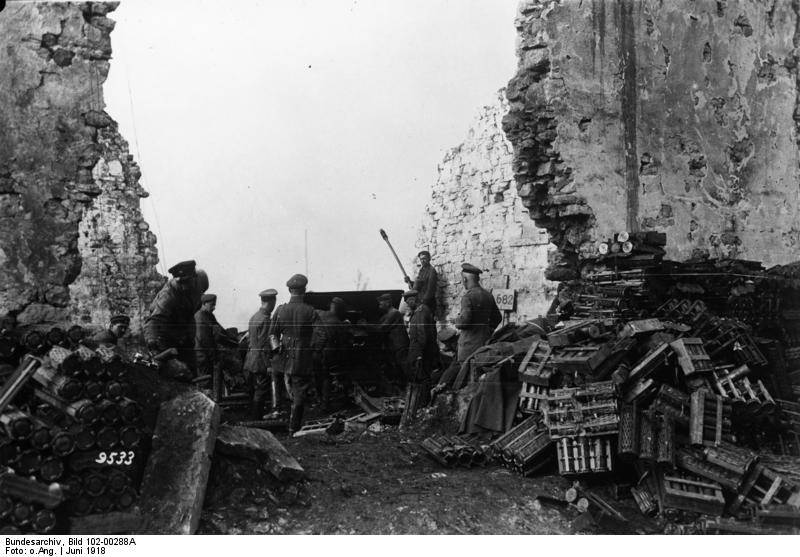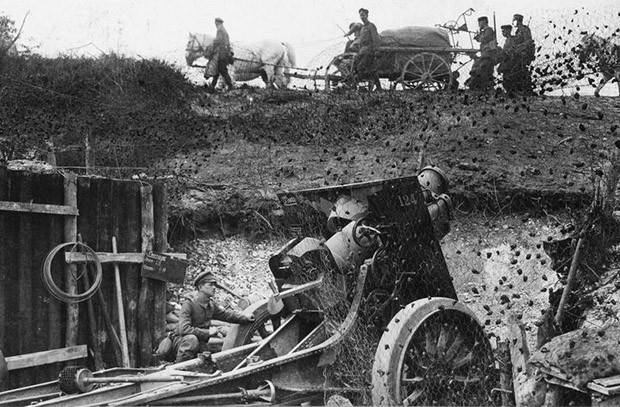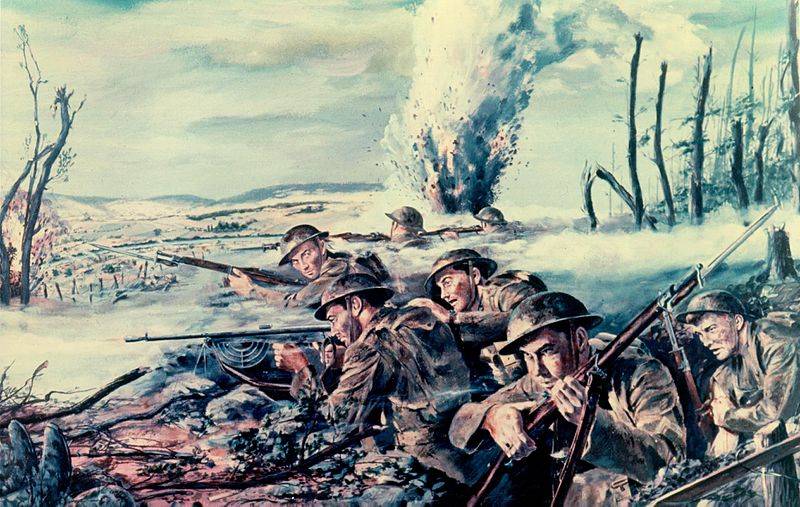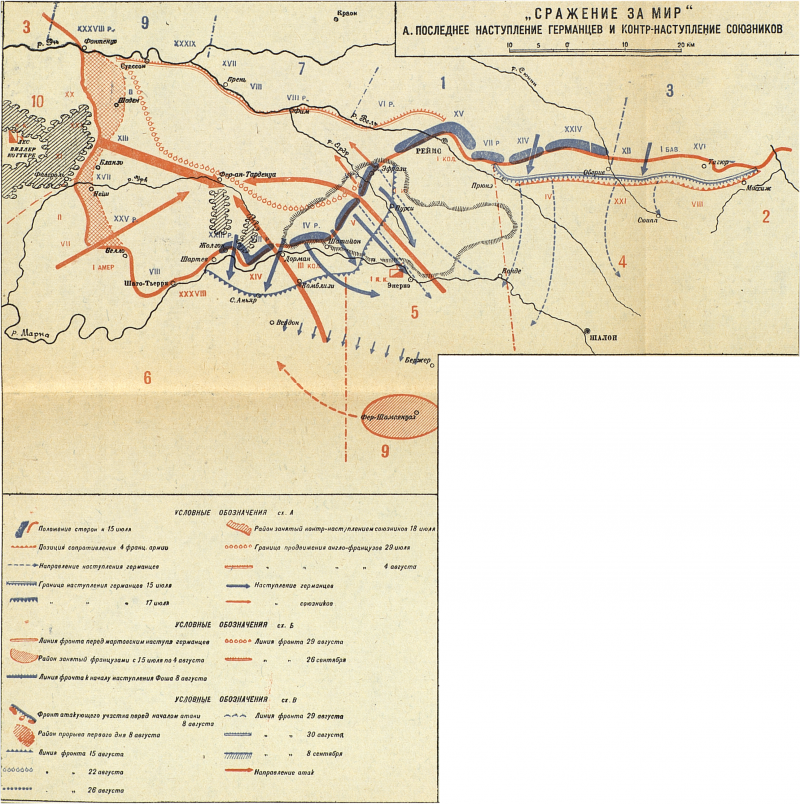How the Russians helped France win the Marne battle again
Preparation offensive
After the Anglo-French troops stopped the German attack on the river. Ena allied command was not only preparing to repel the enemy's strike on the Marne, but also took steps to launch a counteroffensive in order to return the strategic initiative lost in the spring of 1918 and launch a decisive offensive. The balance of power in France was generally favorable for the Entente. She had a significant superiority over the Germans in forces and facilities. By the middle of July, the Allies had 200 infantry and 10 cavalry divisions, 19 804 artillery guns (including 8323 large and special power), 5400 aircraft and 1500 tanks. The total strength of the Allied forces was 3 million 592 thousand people. The opposing German forces had 209 infantry divisions, 18 100 artillery guns (including 7300 large and special power), 3000 aircraft and 3 million 273 thousand people.
14 and 16 June 1918, Foch gave the first instructions on the preparation of a counterattack in the Willer-Kottere forest area by the forces of the 10 Army. On July 12, it was decided to strike at both fronts of the Marne bulge on the front from Soissons to Reims with a length of about 130 km. The allies planned to deprive the enemy of the opportunity to use the Suasson railway junction and straighten the front of the allies between Reims and Marna. The main attack was directed to the right flank and rear of the main mass of the German troops, located south-west of Reims, and especially between the rivers Ain and Urk. The 10, 6 and 5 armies were to take part in the attack. 10-I army, which was entrusted with the implementation of the main task, was to break through the German front south of the river. Ena, and 5-I army - on both sides of the river. Ardr. The mission of the 6 Army was to oust the German forces from the southern flank of the Marne bulge. As a result, all three armies were to have a concentric attack in the direction of Fert-en-Tardenois to force the Germans to clear the entire ledge.
In early July, French troops improved their position with local operations. On July 14, the deployment of the 10th Army in the area of the Willer-Kotter forest began. For secrecy, all movements were made at night, the forest completely hid the nearest rear of the French from observing the enemy. Union aviation covered the area from German aircraft. A well-developed network of railways and highways facilitated both the rapid concentration of French troops and their full supply during the operation. On July 15-17, the Allies continued to prepare a counterattack. The 9th Army was also involved in the operation.
18 July 1918 began the 10 Army and left flank (2 and 7 Corps and one division of the 1 American Corps) 6 Army. To achieve greater surprise strike in 10-Yarmia, it was decided to abandon the artillery preparation. The advancing units attacked directly under the cover of the firing shaft. The forward units of the left flank of the 6 Army were to attack the German military outposts and get in touch with the position of the main resistance, and then attack it after an hour and a half artillery preparation. The right flank of the 6 Army, 9 and 5 Army, whose attack was scheduled for July 19, July 18 were to conduct local attacks and artillery shelling of the German positions.

18 infantry and 10 cavalry divisions (including 6 infantry divisions in the first echelon) On the night of July 50 at the front 25-th and cross 3-th army from Fontenoy to Bello stretch in 16 km focused, 2103 artillery pieces, about 1100 aircraft and 500 tanks. The forces of the left flank (20 and 29 reserve, 13 and 17 army corps) 9 and right wing (25 th reserve corps and one division of 8 army corps) 7 Germanic armies occupied very weak positions. There was no solid line of defense. The basis of the defense, the depth of which ranged from 4 to 8 km, was hastily equipped single resistance units, in-depth road ditches, houses adapted for defense, etc. The left flank of the 9 and the right flank of the 7 of the German armies had 18 infantry divisions (of which 10 in the first echelon), 918 guns and about 800 aircraft. Thus, the Allies had a one-and-a-half superiority over the Germans in the number of divisions and aircraft, more than double in artillery. Also, the Allies had a tank group.
Campaign 1918 of the year. French theater. "Battle for Peace". The last offensive of the Germans and the counter-offensive of the Allies (the period from July 15 to August 4). Source: A. Zayonchkovsky. World War 1914 — 1918
Battle
On the morning of July 18, 1918, the French artillery of the 10 and the left flank of the 6 army opened fire on the whole front. At the site of the 10 Army, a barrage of fire was immediately created, under the cover of which the French soldiers, with the support of 213 tanks, attacked the positions of the 9 German Army. The left flank of the 6 Army went on the offensive after an hour and a half artillery preparation. Suddenness was a success. Even before the headquarters of 9 of the German army realized what had happened, the German troops, caught off guard, left the first position. With one attack, the French captured the German resistance centers and in 3,5 hours advanced into the enemy’s position by 4-5 km.
Then, to assist the infantry of the 10 Army, 400 aircraft took off, which were divided into three groups (“floors”) operating at different altitudes. The first "floor" (2 thousand m and above) led the fight against the German fighters. The second "floor" (from 1 thousand to 2 thousand m) was intended to combat enemy reconnaissance aircraft. Aircraft of the third "floor" attacked ground targets, bombarded the enemy rear. After a hard fight in the sky in the evening, the allies took up.
The commander of the 10 Army, believing that the tactical defense of the enemy was broken through to the full depth, ordered to continue the offensive in 9 hours. For the development of the first success, the 2 Cavalry Corps was sent. However, the cavalry moved very slowly through Willer-Kotter forest, since all the roads were filled with people and equipment. As a result, the cavorpus came out of the forest with a great delay, and by that time it became clear that there was no free passage, since the German defense was not yet broken.
Thus, as a result of the July 18 counterstroke, the 1918 of the year was the German front from the r. Klinyon to r. Ena was shocked. 10-I army advanced on 9 km, and 6-I - on 5 km, there was a threat of exit of French troops to the railway, passing east of Soissons, in the center of the Marne protrusion. The German command was forced to stop the transfer of troops for the impending strike in Flanders and send four divisions to the Soissons area. The first reinforcements arrived the next morning.
On July 19, the 5 and 9 armies joined the offensive. The battles now encompassed the entire front of the Marn. The Germans put up more and more stubborn resistance, the Allies suffered heavy losses, especially in tanks, and their offensive rate fell. German divisions, restraining the onslaught of the enemy, consistently, in perfect order, retreated to the line r. Urk, and then on the rivers Ena and Vel, to the positions that the Germans occupied before the onset of 27 in May. 23 - July 29 continued the advance of the troops of the Entente. The Allies successfully pushed back the Germans who had tried to advance earlier. The failure of the German offensive led to the abandonment of Ludendorff’s plan for a further invasion of Flanders. From this time on, the Germans only retreated to the very end of the war. 2 August the French occupied Soissons, and the next day reached the river. Vel. 4 August the Entente's counter-attack on the Marne stopped.

Disguised position of a French heavy howitzer, captured by German troops during the Second Battle of Marne. July 1918 of the year
Results
As a result, the Allies took to the line r. Vel, pushing the German troops 40 km. The front line was reduced by 45 km. Paris was spared from the threat of assault. The losses of the German troops amounted to 60 thousand people, the Allies lost 101 thousand people.
Militarily, we can note the fact that despite the suddenness of the strike and the massive use of tanks and aircraft, the success was accompanied by the French only on the first day of the counter-offensive. Subsequently, the Germans came to their senses and fiercely resisted, and the Allied offensive was reduced to the frontal repression of the enemy. In this case, the French suffered heavy losses.
Strategically, the Allied victory in the Second Battle of the Marne was of great importance. The Germans were defeated, hopes for a decisive victory and the world was no more. The army was psychologically broken down, the soldiers were tired of war and wanted peace. Inspired by their great success, the allies saw in him a harbinger of total victory. The strategic initiative passed to the allies. So, 24 July 1918 was held in Bombon, a meeting of the commanders of the allied armies of Petain, Haig and Pershing, where the commander-in-chief of the forces of the Western Front, General Foch, outlined a plan for further operations. The main idea of this plan was to abandon the defensive line of action and go on the offensive.
The German command was disappointed with the failures of the second half of July - early August 1918, but also realized that this was a complete failure of an offensive strategy. The Russian military historian, General Andrei Zayonchkovsky, wrote: “It (the German command is the Author) also had 204 divisions, of which 70 were in reserve. Under these conditions, Hindenburg decided not to abandon the initiative and undertake new, necessarily sudden offensive operations, but on a reduced scale, both towards the coast and on other sectors of the front, in order to improve their situation, inflict losses on the allies and show them that German power is far from being broken. This circumstance, according to the main German command, could even incline the Entente to peace negotiations. ... But the command, having lost the initiative, did not quite clearly imagine that the crisis on Marne was the beginning of the end of world war. This alone can explain the desire of him to undertake the offensive again, despite the daily increasing superiority of the allied forces and means. ”
As a result, the German command's plans for a new offensive will not be realized: just three days later, 8 August 1918, the famous “One-Day Offensive” by the Entente armies will begin on almost the whole front, which will lead to their complete victory and the end of the war. The German offensive led to the complete exhaustion of the army and it will no longer be able to provide such resistance to stop the enemy.
A strategic mistake will be the intervention in Russia and the occupation of Western Russian regions. In fact, Russia will again assist the Entente to defeat the German bloc. From the East, Russia to Germany and Austria-Hungary went trains with grain, meat, lard, coal and other products and goods. But in order to get all this, the Austro-German garrisons had to be placed in the Russian regions. To avoid unnecessary problems, the Germans postponed plans for Germanization and deportations until better times, and headed for "cultural" integration. Berlin tried to “friendly” include Ukraine, Finland and other national state entities in its sphere of influence. National governments were given the appearance of "independence", provided patronage for landowners, capitalists, industrialists, refused general raids and requisitions. But from the peasants demanded mandatory delivery of products, mobilized workers, railway workers. They shot for the disobedience of the occupational administration, riots.
But the occupation of western Russia, the actions of the invaders and their local henchmen led to the spontaneous partisan movement, which in 1915 - 1916. unsuccessfully tried to organize the royal power. In 1918, it flared up by itself. Enemy garrisons were scattered over a large space and could not control the entire territory. Enough abandoned, ownerless weapons, ammunition and ammunition, and yesterday's soldiers had a great combat experience. Bases became villages and villages where self-defense units were created in order to fight off the gangsters, and often the nationalists who were not different from them, white or red. Thus, in Belarus, a detachment of grandfather Talash, partisans of Dukorsky Forest, Rudobelskiy forests acted. In Little Russia, the old Makhno, Kotovsky and other chieftains walked. And ordinary peasants did not hasten to hand over bread and cattle, armed themselves, gave a rebuff. The Germans had to organize punitive expeditions in order to appease the partisans and collect food.
As a result, the Austrians and Germans had to keep more than 50 divisions in the East (not counting Turkey, which conducted military operations in the Caucasus). Of these, 33 - 39 German divisions. These were not the best units, most often Landwehr, or divisions, bloodless in battles, set aside for rest to the deep rear. But still it was 15 - 19 cases, which just did not have enough for the last onslaught on Paris. In addition, in Russia, the Austro-German troops were infected with revolutionary sentiment, and carried them further, to Germany, Austria, on the Western Front, where the restored units returned. And the Austro-German prisoners who were released in Russia and returned to their homeland were already fighters of dubious quality. They did not want to fight anymore, but they learned how to rally, independently establish contact with the enemy, and spoil the combat-ready compounds.

The first battle of the 38 American Regiment. July 1918 of the year
- Alexander Samsonov
- 1918 Campaign
US world domination strategy
Turkish invasion of the Caucasus
Romanian invasion of Bessarabia
How Romanian executioners exterminated Russian soldiers
German "fist strike" for the purpose of occupation of the western part of Russia
How the Germans occupied the western part of Russia
100 years "lousy" Brest world
100 years of the Baltic Fleet Ice Campaign
Spring Offensive of the German Army
"We will break the gap, the rest will be by itself"
Pyrrhic victory of the German army
Battle on Fox
German divisions in 56 kilometers from Paris
How the Italian "caimans Piave" beat the Austrians
How the German army lost the "battle for peace"

Information